Welcome back to “Family Fridays!”
I’m thrilled for this week’s installment of “Family Fridays” because today I get to introduce you to my Madrid study abroad director and dear amiga, Ani. I met her in the fall of 2000 (¡como pasa el tiempo!), and we’ve remained in touch ever since. She is the person whom I credit with inspiring me to raise my child(-ren…) bilingually. I’ve learned so much from her and love her dearly. Ani has a lot of wisdom to share from her years of experience raising her two sons bilingually (Spanish and English).
Last week we heard about the multilingual experience of a family with small children and this week we get to hear about what it’s like with teenagers. Fun!
Oh, and one more thing! Ani is also an amazing artist! Check out her website/blog to see her beautiful craftsmanship.
Give a brief snapshot of your family’s language dynamics and your family’s language policy (what language(s) do you speak, who speaks what with whom?).
My husband is a Spaniard (who has visited the States but never lived there) with middle to high level in English. I am bilingual and bicultural, having been raised in the States by a Spanish mom and a Ukrainian father. Spanish was always spoken at my home (“la lengua franca”) and we traveled almost every summer to Spain (and an occasional academic year). After graduating from college in the States I moved permanently to Spain. We have two sons (Daniel: 18 and Paul: 15) who have been brought up using both languages at home, and have always lived in Madrid. Unfortunately, we rarely have the opportunity to go to the States with them. When I speak to the children, it is in English and when their father speaks to them, it is in Spanish. At the dinner table, depending on who is speaking, it is in either language. Children are expected to respond in the language that corresponds to each parent. However, Spanish does prevail in the ambiguous situations. When my sons were young, they spoke in English amongst themselves but that soon changed when they started going to a local school and Spanish became dominant between the two.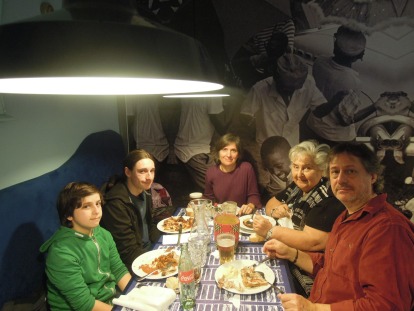 What prompted your decision to raise your children bi-/multi-lingually?
What prompted your decision to raise your children bi-/multi-lingually?
Since I was raised bilingual, it seemed it was the only natural way to recognize my parents’ effort and thank them. Aside from the obvious benefits, there was also a personal motivation (that was in no way rational): all of my siblings had tried to raise bilingual children without succeeding and scoffed at the idea when I claimed I would do it. Nothing like sibling rivalry to meet a challenge!
What positive growth or results have you witnessed in your children/family because of their multilingualism?
The advantages show especially in the academic and social circles: at school in their English class or using English reference books for projects; on a communicative level, speaking with their American side of the family (such as their cousins), foreign kids at summer camps, etc. In addition, Daniel has also found part-time jobs using his English. However, the most important aspect is that they are developing into more open-minded individuals that are capable of addressing the unknown (whether it be an action, a person or a type of food) more naturally. And this derives from the flexibility exerted and multicultural influence that their circumstance offers them. 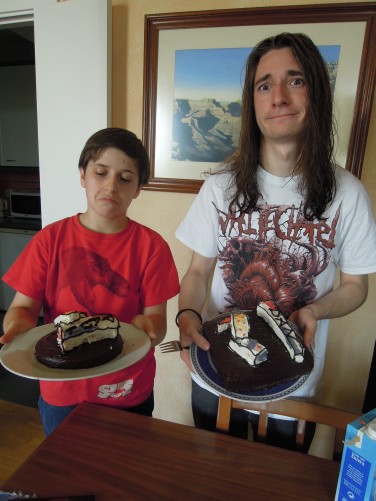 What challenges have you faced or are you facing with language rearing and learning? How do you handle them?
What challenges have you faced or are you facing with language rearing and learning? How do you handle them?
With the first child, Daniel, very few challenges presented themselves aside from getting into the habit of consistently using English with him (while continuing to speak in Spanish to my husband and extending family here). But it was fairly easy because my son is a structured person and would even correct me if I faltered using Spanish on him. Actually, developing this routine was most difficult when he was a newborn because I felt awkward /rude saying things to him in English in front of his Spanish-speaking grandparents, parents in the park, etc…. But of course, it is probably the most important time in a child’s life to hear multiple languages. The second challenge I faced was that I had been brought up in the reverse language: Spanish. That meant that my affectionate vocabulary, lullabies, and children games were all in Spanish. I literally had to learn songs by purchasing CD’s with lyrics and all sorts of videos in English and felt strange, even phony when using terms like “dear,” “honey,” I love you”…. Ironically, with Paul it was much more difficult (in spite having the routine consolidated) simply because he was less receptive. Though at a preschool age he was mostly an English speaker (since both his brother and I spoke to him in English), he immediately preferred Spanish when he began school at age 3. I think it was about “fitting in.” Some child at school made fun of him because he had an American mother and spoke English and for two full years (he was approximately 10 years old then) it was a struggle to have him speak in English to me in public (and later on, even at home). This resulted in our literally not speaking to each other (sometimes in a violent way) since I refused to accept his responses in Spanish. As a result, he lost the habit of using English and to a certain extent, it actually damaged our relationship a bit. However, after this period he was finally convinced to speak in English (I believe he too felt the distancing in our relationship and my husband was very supportive in helping him see that he was missing out on a positive opportunity). As a result of the rejection, he lost the English speaking routine and he would automatically start his conversation in Spanish. So he needed prompting to switch into English for an additional year. We are still “paying” for this stumbling stone, since his English is not up to par yet, but we are making fast progress. On one hand, my refusal to not speak to Paul unless we conversed in English finally got him to use the language again. I suspect many children become semi-bilingual in similar cases because many parents give up and permit them to respond in the language that comes easiest to them. I admit it was taxing and a bit risky since it did put a dent in our relationship. However, I was aware of that and made sure to reach out to him in other ways to make him see that I still loved him. So we ended up bonding in other ways to supplement those hard moments. 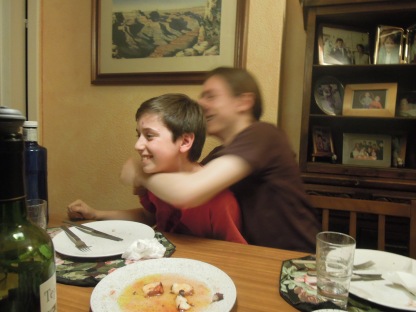 Can you talk about the cultural aspect of bi-/multilingual parenting as it relates to your family?
Can you talk about the cultural aspect of bi-/multilingual parenting as it relates to your family?
American culture is always present in our family, not only because they have family in the States but because we do make an effort to celebrate American holidays, eat American foods, and watch American films. Halloween parties were the big hit in the neighborhood and all their classmates and cousins wanted to be invited! Daniel spent 6 months in an American high school living with his cousins and the Paul will be going for an educational experience in the States (hopefully soon). Sometimes it is my husband who has to do the adapting. Amongst ourselves, cultural issues do arise which have affected our views on childrearing. We have had different views on topics such as part-time work. I managed to convince the father and eldest son about the importance of working part-time while in school. As a result the eldest has taught private classes in English and music and is more sensitive to the expense of things and the value of work. In Spain, working part-time in a restaurant or a store is not as easy as in the States (for cultural reasons and as a result of high unemployment in the country) so I have had to accept that he wasn’t going to be able to work as many hours in the types of places I would have wanted him to. We all had to adapt.
Share a memorable moment you and your family experienced with language learning, something that shed light or taught you a lesson about bi-/multilingual parenting.
My mom always talks about Daniel’s first realization of the two languages when he was about 2 and a half years old (yes, he started talking later than most kids). She says that one day that she was babysitting, he told her repeatedly in the few words he knew that Papá “si,” Mommy “yes.” Paul was baptized as Pablo but I started calling him Paul upon realizing that half of the newborns in Madrid were named Pablo. My husband (and the Spanish speaking side of the family) still called him Pablo until Paul stood up to him one day (at about age 3) and corrected him saying, “papá, me llamo Paul, no Pablo.”(Dad, my name is Paul, not Pablo). 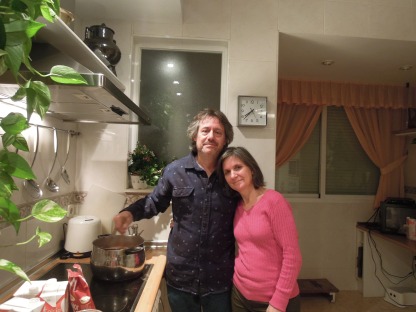 How do you involve your family, community, school and/or world at large in this bicultural adventure?
How do you involve your family, community, school and/or world at large in this bicultural adventure?
I have supported the local grade school with their English development by connecting them with American programs that could provide them with education majors that wanted to internship in the Spanish school as teachers’ aids in the English classes. Most of the Spanish side of our family does place great importance in learning English, sending their kids to bilingual schools, but then again, in Spain this is a general practice so the extent of our influence in the matter is questionable.
What advice or encouragement can you share with other families raising their children multi-lingually?
I believe the most important thing is consistency. A family can use more than one language in the home but each language should be directed to a specific person or it can get confusing as to when to use one or the other (making the use of whichever language legitimate if there aren’t specific ground rules). I found that sometimes using the less dominant language can affect your relationship with the child (especially since they know you understand both languages) so you need to find savvy ways of communicating that you still recognize and love the child, but use “my” language. One of the first situations I faced was when my son said his first real word: “zapato” (shoe in Spanish)! I was so excited and wanted so much to reward him for having said an understandable word. But at the same time, I needed him to recognize that it was in the other language. So I responded to him in English saying…”Great, Dan, you said SHOE.” I did learn that the act of learning to read and reading in another language are two different things. I was told to raise them speaking bilingual simultaneously, but to not try to teach them to read in both languages at the same time. And it worked! I had them learn to read in the dominant language and once they assimilate this process (recognizing written characters that form words), then addressed learning to read in English. I was amazed that when I confronted them with their first English reader (at about 7 years in age), all I had to do was explain some of the “strange spellings” and they picked it up from there. Within a short period, they were intuitively reading words and not sounding them out based on spelling. And though this sounds obvious, watching TV or movies in the non-dominant language helps tremendously! My kids started to complain when a show was on in Spanish because they had associated TV, just like their mom, with English!
Freebie! Anything else come to your mind about the issue of multilingual parenting?
Two languages in the home can be fun too. Often we make up words or phrases that express to multi-cultural ideas in one…such as “dame un roto” (poor translation of give me a break, but with no real direct translation into Spanish) or simply, inside jokes. Choosing names: We tried to find names that would work well in both languages. Our mistake with Daniel is that it is spelled the same in both languages but the accent is placed on a different syllable. So, if you pronounce it the Spanish way, it sounds like Danielle (a female name) in English. And my Spanish mom couldn’t get it right and her American friends kept asking if her grandchild was a boy or a girl! And then, Pablo went to Paul (and Spaniards think it is spelled Pol). A final note: I just ask my sons what they felt were the advantages and the disadvantages of being bilingual and bicultural. They said, “Well the advantages are obvious!” And what are the disadvantages? Both coincided that they did not feel 100% Spanish or American; they didn’t totally fit in. I agree, I have always felt that way myself. Maybe we are just 80% of each, but still, that totals 160%.
¡Somos the milk!


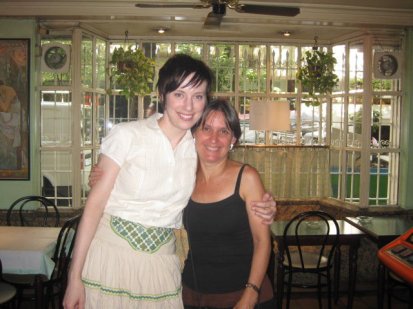

Pingback: “A Gift for the Future” (Family Fridays) | Españolita...¡sobre la marcha!
Pingback: On my bedside table (and, in my Feedly) | Españolita...¡sobre la marcha!
Pingback: “What a Joy it is!” (Family Fridays) | Españolita...¡sobre la marcha!
Pingback: “Educate yourself about Bilingualism” (Family Fridays) | Españolita...¡sobre la marcha!
Pingback: “I want them to respect all cultures.” (Family Fridays) | Españolita...¡sobre la marcha!
Pingback: A Bilingual Baby’s First Year – Laying the Foundation | Españolita...¡sobre la marcha!
Pingback: Around the World in 5 1/2 Months (A Family Fridays Roundup) | Españolita...¡sobre la marcha!
Pingback: Looking back: a six-month reflection | Españolita...¡sobre la marcha!
Pingback: Hola, I’m Españolita, and this is nuestra familia (Family Fridays) | Españolita...¡sobre la marcha!